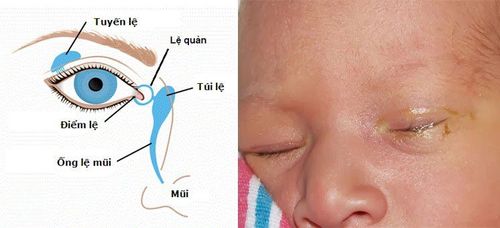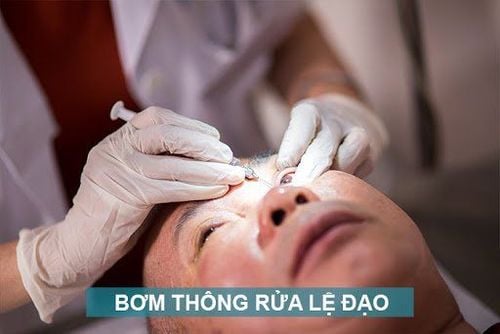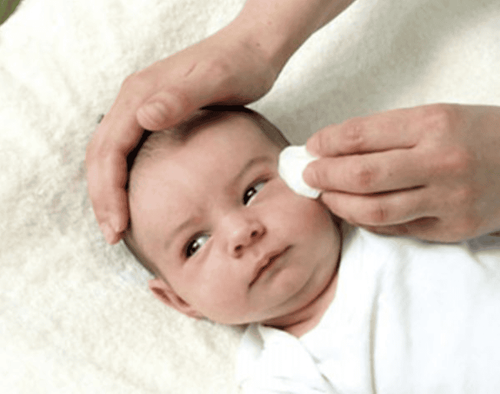This is an automatically translated article.
The article was written by Doctor Ngo Van Dan - Department of Neonatology - Vinmec Times City International General Hospital.
Normally, tears are produced by the lacrimal glands, keeping the eyes lubricated and clean. After tears are produced, with eye movement, the tears are forced into the ducts in the inner corner, whereby the tears exiting the eye drip down the lacrimal duct into the back of the nose. If this duct is completely or partially blocked, tears that do not drain out will block the lacrimal duct.
1. Discipline is often caused by the following reasons
No tear points : The child will always have persistent lacrimation and conjunctivitis. Congenital lacrimal fistula: The skin near the inner corner of the eye has a small fistula that causes tears to flow through this fistula. Congenital tear duct obstruction: This is the most common occurrence occurring in about 5% of infants 12-20 days old. The disease can occur in one or both eyes, sometimes causing watery eyes, if frequent and prolonged can produce pus, conjunctivitis, swelling of the lacrimal sac. The cause of congenital occlusion of the lacrimal duct is also due to the incomplete formation of the lacrimal canal in the fetus, so at the lower end of the nasolacrimal duct the membrane remains blocked, in some other cases it is due to the deformity of the bony canal of the lacrimal duct. nasal tear duct. When the tear duct is blocked, the inner corner of the eye may be slightly swollen and tense. If the obstruction persists for a long time, especially if the nasolacrimal duct is not treated, it can cause chronic pouchitis. Stagnant tears in the lacrimal sac can cause an infection in the lacrimal tract, an inflamed tear duct, and purulent mucus. Pressing on this area has mucus and pus coming out at the corner of the eye, causing an abscess in the tear bag, even causing leakage, pus out of the skin, a lot of pain, swelling and redness in the inner corner of the eye.
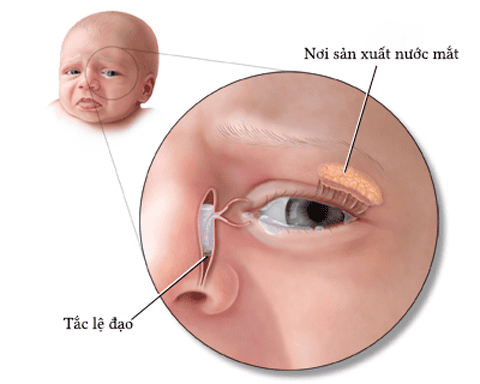
2. Signs of tear duct obstruction in infants
Newborns often have watery eyes and rusty eyes. The phenomenon of tears (not crying) will be more when it is cold, windy or sunny... Especially, every morning when children wake up, their eyes often have a lot of yellow rust sticking around their eyelids. Children's eyes are always wet like has just cried due to tears in the slits of the eyelids Pseudo-conjunctivitis, often red skin of the eyelids, children often rub their eyes Signs of obstruction of the lacrimal duct can be easily recognized or not due to complete or partial obstruction. If the blockage is partial, it may take a while for the parents of young children to notice the "special" in their children's eyes. Note when treating at home?
2.1 Wash your baby's eyes Use physiological saline in the form of eye drops, soak a cotton ball in water and then gently wipe the baby's eyes, removing all the yellow stains on the baby's eyes. It is recommended to do many times regularly to keep your baby's eyes clean. While doing it, be very gentle and careful to avoid infection.
Parents need to wash their hands with soap or a quick antiseptic solution before and after cleaning the baby's eyes. Eye drops containing antibiotics are only used in case the baby has conjunctivitis and has a doctor's prescription.
2.2 Massage the lacrimal gland Using your (cleaned) index finger, gently massage the corner of your baby's inner eye, starting to move from the inner corner of the eyelid towards the baby's nose. The massage will apply gentle pressure to the ducts, helping to clear fluid from clogged passages and open them up. Parents should do it many times, about 2-4 times a day to ensure high efficiency, do each time for about 5-10 minutes.
If the above measures do not work, the best way is to take your child to see a doctor at a specialist eye hospital. Depending on the condition of each child, the doctor has a separate treatment, can use medicine or use the method of tear drainage.
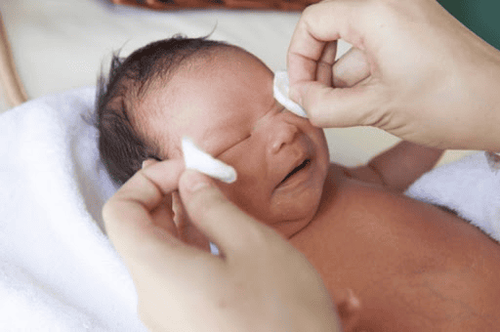
3. What are the treatments on admission? Which cases need re-examination?
Treatment of congenital lacrimal occlusion will be performed according to age and cause of lacrimal obstruction. If the cause is the absence of lacrimal points due to the diaphragm at the lacrimal point, an incision can be made as a common practice.
If the cause is a lacrimal fistula, it is treated by surgically closing the fistula. If the cause is congenital tear duct obstruction, depending on the age, the doctor will prescribe appropriate treatment.
For children under 3 months of age, the main treatment is massaging the lacrimal sac, wiping the eyelids with physiological saline, if there is pus, antibiotic eye drops as prescribed by the doctor.
For children 3-12 months, treat with lacrimal irrigation, a combination of topical antibiotics and routine vaginal discharge. However, the practice of directing is only done after irrigation and manipulation of the lacrimal sac area and the use of antibiotics has not been effective.
For children over 1 year of age, the conventional method of drainage is often ineffective, so it is necessary to bring the child to the doctor to evaluate the surgery to connect the lacrimal sac.
For infants, when detecting that the child has live tears or often sees water in the slit of the eyelids, parents should take the child to the doctor immediately so that the doctor can determine the exact cause of the tear, rule out other causes. Other causes such as congenital glaucoma, inflammation in the eye and appropriate treatment measures.
Pediatrics department at Vinmec International General Hospital is the address for receiving and examining diseases that infants and young children are susceptible to: viral fever, bacterial fever, otitis media, pneumonia in children, .... With modern equipment, sterile space, minimizing the impact as well as the risk of disease spread. Along with that is the dedication from the doctors with professional experience with pediatric patients, making the examination no longer a concern of the parents.
Please dial HOTLINE for more information or register for an appointment HERE. Download MyVinmec app to make appointments faster and to manage your bookings easily.





